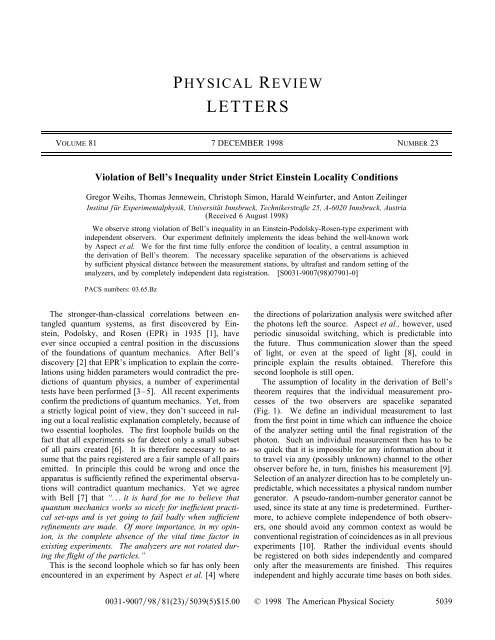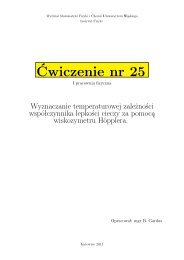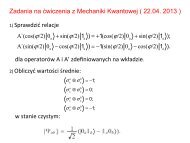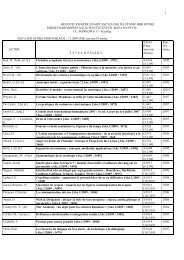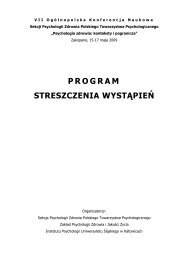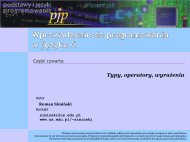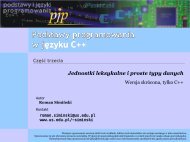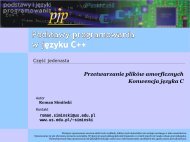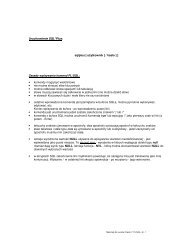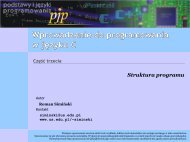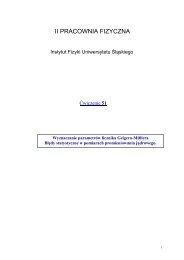Violation of Bell inequality under strict Einstein locality conditions
Violation of Bell inequality under strict Einstein locality conditions
Violation of Bell inequality under strict Einstein locality conditions
You also want an ePaper? Increase the reach of your titles
YUMPU automatically turns print PDFs into web optimized ePapers that Google loves.
PHYSICAL REVIEW<br />
LETTERS<br />
VOLUME 81 7 DECEMBER 1998 NUMBER 23<br />
<strong>Violation</strong> <strong>of</strong> <strong>Bell</strong>’s Inequality <strong>under</strong> Strict <strong>Einstein</strong> Locality Conditions<br />
Gregor Weihs, Thomas Jennewein, Christoph Simon, Harald Weinfurter, and Anton Zeilinger<br />
Institut für Experimentalphysik, Universität Innsbruck, Technikerstraße 25, A-6020 Innsbruck, Austria<br />
(Received 6 August 1998)<br />
We observe strong violation <strong>of</strong> <strong>Bell</strong>’s <strong>inequality</strong> in an <strong>Einstein</strong>-Podolsky-Rosen-type experiment with<br />
independent observers. Our experiment definitely implements the ideas behind the well-known work<br />
by Aspect et al. We for the first time fully enforce the condition <strong>of</strong> <strong>locality</strong>, a central assumption in<br />
the derivation <strong>of</strong> <strong>Bell</strong>’s theorem. The necessary spacelike separation <strong>of</strong> the observations is achieved<br />
by sufficient physical distance between the measurement stations, by ultrafast and random setting <strong>of</strong> the<br />
analyzers, and by completely independent data registration. [S0031-9007(98)07901-0]<br />
PACS numbers: 03.65.Bz<br />
The stronger-than-classical correlations between entangled<br />
quantum systems, as first discovered by <strong>Einstein</strong>,<br />
Podolsky, and Rosen (EPR) in 1935 [1], have<br />
ever since occupied a central position in the discussions<br />
<strong>of</strong> the foundations <strong>of</strong> quantum mechanics. After <strong>Bell</strong>’s<br />
discovery [2] that EPR’s implication to explain the correlations<br />
using hidden parameters would contradict the predictions<br />
<strong>of</strong> quantum physics, a number <strong>of</strong> experimental<br />
tests have been performed [3–5]. All recent experiments<br />
confirm the predictions <strong>of</strong> quantum mechanics. Yet, from<br />
a <strong>strict</strong>ly logical point <strong>of</strong> view, they don’t succeed in ruling<br />
out a local realistic explanation completely, because <strong>of</strong><br />
two essential loopholes. The first loophole builds on the<br />
fact that all experiments so far detect only a small subset<br />
<strong>of</strong> all pairs created [6]. It is therefore necessary to assume<br />
that the pairs registered are a fair sample <strong>of</strong> all pairs<br />
emitted. In principle this could be wrong and once the<br />
apparatus is sufficiently refined the experimental observations<br />
will contradict quantum mechanics. Yet we agree<br />
with <strong>Bell</strong> [7] that “. . . it is hard for me to believe that<br />
quantum mechanics works so nicely for inefficient practical<br />
set-ups and is yet going to fail badly when sufficient<br />
refinements are made. Of more importance, in my opinion,<br />
is the complete absence <strong>of</strong> the vital time factor in<br />
existing experiments. The analyzers are not rotated during<br />
the flight <strong>of</strong> the particles.”<br />
This is the second loophole which so far has only been<br />
encountered in an experiment by Aspect et al. [4] where<br />
the directions <strong>of</strong> polarization analysis were switched after<br />
the photons left the source. Aspect et al., however, used<br />
periodic sinusoidal switching, which is predictable into<br />
the future. Thus communication slower than the speed<br />
<strong>of</strong> light, or even at the speed <strong>of</strong> light [8], could in<br />
principle explain the results obtained. Therefore this<br />
second loophole is still open.<br />
The assumption <strong>of</strong> <strong>locality</strong> in the derivation <strong>of</strong> <strong>Bell</strong>’s<br />
theorem requires that the individual measurement processes<br />
<strong>of</strong> the two observers are spacelike separated<br />
(Fig. 1). We define an individual measurement to last<br />
from the first point in time which can influence the choice<br />
<strong>of</strong> the analyzer setting until the final registration <strong>of</strong> the<br />
photon. Such an individual measurement then has to be<br />
so quick that it is impossible for any information about it<br />
to travel via any (possibly unknown) channel to the other<br />
observer before he, in turn, finishes his measurement [9].<br />
Selection <strong>of</strong> an analyzer direction has to be completely unpredictable,<br />
which necessitates a physical random number<br />
generator. A pseudo-random-number generator cannot be<br />
used, since its state at any time is predetermined. Furthermore,<br />
to achieve complete independence <strong>of</strong> both observers,<br />
one should avoid any common context as would be<br />
conventional registration <strong>of</strong> coincidences as in all previous<br />
experiments [10]. Rather the individual events should<br />
be registered on both sides independently and compared<br />
only after the measurements are finished. This requires<br />
independent and highly accurate time bases on both sides.<br />
0031-90079881(23)5039(5)$15.00 © 1998 The American Physical Society 5039
VOLUME 81, NUMBER 23 PHYSICAL REVIEW LETTERS 7DECEMBER 1998<br />
Time [µs]<br />
1<br />
0<br />
-200<br />
Y<br />
Alice<br />
X<br />
Source<br />
Space [m]<br />
Bob<br />
200<br />
FIG. 1. Spacetime diagram <strong>of</strong> our <strong>Bell</strong> experiment. Selecting<br />
a random analyzer direction, setting the analyzer, and finally<br />
detecting a photon constitute the measurement process. This<br />
process on Alice’s side must fully lie inside the shaded region<br />
which is invisible to Bob’s during his own measurement. For<br />
our setup this means that the decision about the setting has<br />
to be made after point “X” if the corresponding photons are<br />
detected at spacetime points “Y” and “Z”, respectively. In our<br />
experiment the measurement process (indicated by a short black<br />
bar) including the choice <strong>of</strong> a random number took less than<br />
only one-tenth <strong>of</strong> the maximum allowed time. The vertical<br />
parts <strong>of</strong> the kinked photon world lines emerging from the<br />
source represent the fiber coils at the source location, which<br />
are obviously irrelevant to the <strong>locality</strong> argument.<br />
In our experiment, for the first time, any mutual influence<br />
between the two observations is excluded within the<br />
realm <strong>of</strong> <strong>Einstein</strong> <strong>locality</strong>. To achieve this condition the<br />
observers “Alice” and “Bob” were spatially separated by<br />
400 m across the Innsbruck University science campus,<br />
which in turn means that the individual measurements as<br />
defined above had to be shorter than 1.3 ms, the time for<br />
direct communication at the speed <strong>of</strong> light. We used polarization<br />
entangled photon pairs which were sent to the observers<br />
through optical fibers [11]. About 250 m <strong>of</strong> each<br />
500 m long cable was laid out and the rest was left coiled<br />
at the source (see Fig. 1). The difference in fiber length<br />
was less than 1 m, which means that the photons were registered<br />
simultaneously within 5 ns. The duration <strong>of</strong> an individual<br />
measurement was kept far below the 1.3 ms limit<br />
using high speed physical random number generators and<br />
fast electro-optic modulators. Independent data registration<br />
was performed by each observer having his own time<br />
interval analyzer and atomic clock, synchronized only once<br />
before each experiment cycle.<br />
Our source <strong>of</strong> photon pairs is degenerate type-II parametric<br />
down-conversion [5] where we pump a BBO crystal<br />
with 400 mW <strong>of</strong> 351 nm light from an argon-ion laser.<br />
Z<br />
A telescope was used to narrow the UV-pump beam [12],<br />
in order to enhance the coupling <strong>of</strong> the 702 nm photons<br />
into the two single-mode glass fibers. On the way to the<br />
fibers, the photons passed a half-wave plate and the compensator<br />
crystals necessary to compensate for in-crystal<br />
birefringence and to adjust the internal phase w <strong>of</strong> the<br />
entangled state jC 1 p 2 jH 1 jV 2 1 e iw jV 1 jH 2 ,<br />
which we chose w p.<br />
The single-mode optical fibers had been selected for a<br />
cut<strong>of</strong>f wavelength close to 700 nm to minimize coupling<br />
losses. Manual fiber polarization controllers were inserted<br />
at the source location into both arms to be able to<br />
compensate for any unitary polarization transformation in<br />
the fiber cable. Depolarization within the fibers was found<br />
to be less than 1% and polarization proved to be stable<br />
(rotation less than 1 ± ) within 1 hour.<br />
Each <strong>of</strong> the observers (see Fig. 2) switched the direction<br />
<strong>of</strong> local polarization analysis with a transverse<br />
electro-optic modulator. Its optic axis was set at 45 ±<br />
with respect to the subsequent polarizer. Applying a voltage<br />
causes a rotation <strong>of</strong> the polarization <strong>of</strong> light passing<br />
through the modulator by an angle proportional to the<br />
voltage [13]. For the measurements the modulators were<br />
switched fast between a rotation <strong>of</strong> 0 ± and 45 ± .<br />
The modulation systems (high-voltage amplifier and<br />
electro-optic modulator) had a frequency range from dc<br />
to 30 MHz. Operating the systems at high frequencies<br />
we observed a reduced polarization contrast <strong>of</strong> 97% (Bob)<br />
and 98% (Alice). This, however, is no real depolarization<br />
but merely reflects the fact that we are averaging over<br />
the polarization rotation induced by an electrical signal<br />
from the high-voltage amplifier, which is not <strong>of</strong> perfectly<br />
rectangular shape.<br />
The actual orientation for local polarization analysis was<br />
determined independently by a physical random number<br />
FIG. 2. One <strong>of</strong> the two observer stations. A random number<br />
generator is driving the electro-optic modulator. Silicon<br />
avalanche photodiodes are used as detectors. A “time tag” is<br />
stored for each detected photon together with the corresponding<br />
random number “0” or “1” and the code for the detector “1”<br />
or “2” corresponding to the two outputs <strong>of</strong> the polarizer.<br />
5040
VOLUME 81, NUMBER 23 PHYSICAL REVIEW LETTERS 7DECEMBER 1998<br />
generator. This generator has a light-emitting diode<br />
(coherence time t c 10 fs) illuminating a beam splitter<br />
whose outputs are monitored by photomultipliers. The<br />
subsequent electronic circuit sets its output to “0”(“1”)<br />
upon receiving a pulse from photomultiplier “0”(“1”).<br />
Events where both photomultipliers register a photon<br />
within t # 2 ns are ignored. The resulting binary random<br />
number generator has a maximum toggle frequency<br />
<strong>of</strong> 500 MHz. By changing the source intensity the mean<br />
interval was adjusted to about 10 ns in order to have a<br />
high primary random bit rate [14,15]. Certainly this kind<br />
<strong>of</strong> random-number generator is not necessarily evenly distributed.<br />
For a test <strong>of</strong> <strong>Bell</strong>’s <strong>inequality</strong> it is, however, not<br />
necessary to have perfectly even distribution, because all<br />
correlation functions are normalized to the total number <strong>of</strong><br />
events for a certain combination <strong>of</strong> the analyzers’ settings.<br />
Still, we kept the distribution even to within 2% in order<br />
to obtain an approximately equal number <strong>of</strong> samples<br />
for each setting by changing the internal photoelectron<br />
amplification <strong>of</strong> the two photomultipliers. Because <strong>of</strong><br />
the limited speed <strong>of</strong> the subsequent modulation system it<br />
was sufficient to sample this random number generator<br />
periodically at a rate <strong>of</strong> 10 MHz.<br />
The total <strong>of</strong> the delays occurring in the electronics<br />
and optics <strong>of</strong> our random number generator, sampling<br />
circuit, amplifier, electro-optic modulator, and avalanche<br />
photodiodes was measured to be 75 ns. Allowing for<br />
another 25 ns, to be sure that the autocorrelation <strong>of</strong> the<br />
random number generator output signal is sufficiently<br />
low, it was safe to assume that the specific choice <strong>of</strong><br />
an analyzer setting would not be influenced by any event<br />
more than 100 ns earlier. This was much shorter than<br />
the 1.3 ms that any information about the other observer’s<br />
measurement would have been retarded.<br />
The photons were detected by silicon avalanche photodiodes<br />
with dark count rates (noise) <strong>of</strong> a few hundred<br />
per second. This is very small compared to the 10.000–<br />
15.000 signal counts per second per detector. The pulses<br />
<strong>of</strong> each detector were fed into electronic circuits, responsible<br />
for disregarding events that occurred during transitions<br />
<strong>of</strong> the switch signal and encoding the position <strong>of</strong><br />
the switch in an extra signal. Finally, all detections were<br />
time-tagged in special time interval analyzers with 75 ps<br />
resolution and 0.5 ns accuracy referenced to a rubidium<br />
standard together with the appendant switch position. The<br />
overall dead time <strong>of</strong> an individual detection channel was<br />
approximately 1 ms.<br />
Using an auxiliary input <strong>of</strong> our time interval analyzers<br />
we synchronized Alice’s and Bob’s time scales by sending<br />
laser pulses (670 nm wavelength, 3 ns width) through a<br />
second optical fiber. While the actual jitter between these<br />
pulses was less than 0.5 ns, the auxiliary input <strong>of</strong> the time<br />
interval analyzers had a resolution not better than 20 ns<br />
thus limiting synchronization accuracy. This nonperfect<br />
synchronization only limited our ability to exactly predict<br />
the apparent time shift between Alice’s and Bob’s data<br />
series, but did not in any way degrade time resolution or<br />
accuracy.<br />
Each observer station featured a personal computer<br />
which stored the tables <strong>of</strong> time tags accumulated in<br />
a measurement cycle. Long after measurements were<br />
finished we analyzed the files for coincidences with a third<br />
computer. Coincidences were identified by calculating<br />
time differences between Alice’s and Bob’s time tags and<br />
comparing these with a time window (typically a few ns).<br />
As there were four channels on each side—two detectors<br />
with two switch positions—this procedure yielded 16<br />
coincidence rates, appropriate for the analysis <strong>of</strong> <strong>Bell</strong>’s<br />
<strong>inequality</strong>. The coincidence peak was nearly noise-free<br />
[signal-to-noise ratio SNR . 100] with approximately<br />
Gaussian shape and a width (FWHM) <strong>of</strong> about 2 ns.<br />
All data reported here were calculated with a window<br />
<strong>of</strong> 6 ns.<br />
There are many variants <strong>of</strong> <strong>Bell</strong>’s inequalities. Here we<br />
use a version first derived by Clauser et al. [16] (CHSH)<br />
since it applies directly to our experimental configuration.<br />
The number <strong>of</strong> coincidences between Alice’s detector<br />
i and Bob’s detector j is denoted by C ij a, b with<br />
i, j [ 1, 2 where a and b are the directions <strong>of</strong> the<br />
two polarization analyzers and “1” and “2” denote the<br />
two outputs <strong>of</strong> a two-channel polarizer, respectively. If<br />
we assume that the detected pairs are a fair sample <strong>of</strong><br />
all pairs emitted, then the normalized expectation value<br />
Ea, b <strong>of</strong> the correlation between Alice’s and Bob’s<br />
local results is Ea, b C 11 a, b 1 C 22 a, b 2<br />
C 12 a, b 2 C 21 a, bN, where N is the sum <strong>of</strong> all<br />
coincidence rates. In a rather general form the CHSH<br />
<strong>inequality</strong> reads<br />
Sa, a 0 , b, b 0 jEa, b 2 Ea 0 , bj<br />
1 jEa, b 0 1 Ea 0 , b 0 j # 2. (1)<br />
Quantum theory predicts a sinusoidal dependence for<br />
the coincidence rate C11a, qm<br />
b ~ sin 2 b2a on the<br />
difference angle <strong>of</strong> the analyzer directions in Alice’s and<br />
Bob’s experiments. The same behavior can also be seen<br />
in the correlation function E qm a, b 2 cos2b 2<br />
a. Thus, for various combinations <strong>of</strong> analyzer directions<br />
a, b, a 0 , b 0 these functions violate <strong>Bell</strong>’s <strong>inequality</strong>.<br />
Maximum violation is obtained using the following<br />
set <strong>of</strong> angles Smax qm<br />
S qm 0 ± ,45 ± , 22.5 ± , 67.5 ± 2 p 2 <br />
2.82 . 2.<br />
If, however, the perfect correlations (a 2b0 ± or<br />
90 ± ) have a reduced visibility V # 1 then the quantum<br />
theoretical predictions for E and S are reduced as well by<br />
the same factor independent <strong>of</strong> the angle. Thus, because<br />
the visibility <strong>of</strong> the perfect correlations in our experiment<br />
was about 97% we expect S to be not higher than 2.74<br />
if alignment <strong>of</strong> all angles is perfect and all detectors are<br />
equally efficient.<br />
We performed various measurements with the described<br />
setup. The data presented in Fig. 3 are the result <strong>of</strong> a scan<br />
5041
VOLUME 81, NUMBER 23 PHYSICAL REVIEW LETTERS 7DECEMBER 1998<br />
Coincidences in 5s<br />
800 A+0/B–0<br />
600<br />
400<br />
200<br />
0<br />
600<br />
400<br />
200<br />
0<br />
-0,50π -0,25π 0,00π 0,25π 0,50π<br />
A+1/B–0<br />
A+0/B+0<br />
A+1/B+0<br />
Analyzer Rotation Angle<br />
-100 -50 0 50 100<br />
Bias Voltage (Alice) [V]<br />
FIG. 3. Four out <strong>of</strong> sixteen coincidence rates between various<br />
detection channels as functions <strong>of</strong> bias voltage (analyzer<br />
rotation angle) on Alice’s modulator. A 1 1B 2 0, for<br />
example, are the coincidences between Alice’s “1” detector<br />
with switch having been in position “1” and Bob’s “2” detector<br />
with switch position “0”. The difference in height is explained<br />
by different efficiencies <strong>of</strong> the detectors.<br />
<strong>of</strong> the dc bias voltage in Alice’s modulation system over a<br />
200 V range in 5 V steps. At each point a synchronization<br />
pulse triggered a measurement period <strong>of</strong> 5 s on each side.<br />
From the time-tag series we extracted coincidences after all<br />
measurements had been finished. Figure 3 shows four <strong>of</strong><br />
the 16 resulting coincidence rates as functions <strong>of</strong> the bias<br />
voltage. Each curve corresponds to a certain detector and<br />
a certain modulator state on each side. A nonlinear x 2 fit<br />
showed perfect agreement with the sine curve predicted<br />
by quantum theory. Visibility was 97% as one could<br />
have expected from the previously measured polarization<br />
contrast. No oscillations in the singles count rates were<br />
found. We want to stress again that the accidental coincidences<br />
have not been subtracted from the plotted data.<br />
In order to give quantitative results for the violation <strong>of</strong><br />
<strong>Bell</strong>’s <strong>inequality</strong> with better statistics, we performed experimental<br />
runs with the settings 0 ± ,45 ± for Alice’s and<br />
22.5 ± , 67.5 ± for Bob’s polarization analyzer. A typical observed<br />
value <strong>of</strong> the function S in such a measurement was<br />
S 2.73 6 0.02 for 14 700 coincidence events collected<br />
in 10 s. This corresponds to a violation <strong>of</strong> the CHSH <strong>inequality</strong><br />
<strong>of</strong> 30 standard deviations assuming only statistical<br />
errors. If we allow for asymmetries between the detectors<br />
and minor errors <strong>of</strong> the modulator voltages our result<br />
agrees very well with the quantum theoretical prediction.<br />
While our results confirm the quantum theoretical<br />
predictions [17], we admit that, however unlikely, local<br />
realistic or semiclassical interpretations are still possible,<br />
but we would then have to assume that the sample <strong>of</strong> pairs<br />
registered is not a faithful representative <strong>of</strong> the whole<br />
ensemble emitted. While we share <strong>Bell</strong>’s judgment about<br />
the likelihood <strong>of</strong> that explanation [7], we agree that an<br />
ultimate experiment should also have higher detection/<br />
collection efficiency, which was 5% in our experiment.<br />
Further improvements, e.g., having a human observer<br />
choose the analyzer directions, would again necessitate<br />
major improvements <strong>of</strong> technology as was the case in order<br />
to finally, after more than 15 years, go significantly<br />
beyond the beautiful 1982 experiment <strong>of</strong> Aspect et al. [4].<br />
Expecting that any improved experiment will also agree<br />
with quantum theory, a shift <strong>of</strong> our classical philosophical<br />
positions seems necessary. Among the possible implications<br />
are non<strong>locality</strong> or complete determinism or the<br />
abandonment <strong>of</strong> counterfactual conclusions. Whether or<br />
not this will finally answer the eternal question: “Is the<br />
moon there, when nobody looks?” [18], is certainly up to<br />
the reader’s personal judgment.<br />
This work was supported by the Austrian Science<br />
Foundation (FWF), project S6502, by the U.S. NSF Grant<br />
No. PHY 97-22614, and by the APART program <strong>of</strong> the<br />
Austrian Academy <strong>of</strong> Sciences.<br />
[1] A. <strong>Einstein</strong>, B. Podolsky, and N. Rosen, Phys. Rev. 47,<br />
777 (1935).<br />
[2] J. S. <strong>Bell</strong>, Physics (Long Island City, N.Y.) 1, 195 (1965).<br />
[3] S. J. Freedman and J. F. Clauser, Phys. Rev. Lett. 28, 938<br />
(1972).<br />
[4] A. Aspect, J. Dalibard, and G. Roger, Phys. Rev. Lett. 49,<br />
1804 (1982).<br />
[5] P. G. Kwiat, K. Mattle, H. Weinfurter, A. Zeilinger, A. V.<br />
Sergienko, and Y. Shih, Phys. Rev. Lett. 75, 4337 (1995).<br />
[6] P. Pearle, Phys Rev. D 2, 1418 (1970).<br />
[7] The observation that the photons in a pair, as used by us,<br />
are always found to have different polarization can not as<br />
easily be <strong>under</strong>stood as the fact that the socks in a pair, as<br />
worn by Bertlmann, are always found to have different<br />
colors. J. S. <strong>Bell</strong>, J. Phys. (Paris), Colloq., Suppl. 3,<br />
C2, 41 (1981), reprinted in Speakable and Unspeakable<br />
in Quantum Mechanics (Cambridge University Press,<br />
Cambridge, 1987), pp. 139–158.<br />
[8] A. Zeilinger, Phys. Lett. 118A, 1 (1986).<br />
[9] G. Weihs, H. Weinfurter, and A. Zeilinger, in Experimental<br />
Metaphysics, edited by R. S. Cohen et al. (Kluwer<br />
Academic Publishers, Dordrecht, 1997), pp. 271–280;<br />
G. Weihs, H. Weinfurter, and A. Zeilinger, Acta Phys.<br />
Slovaca 47, 337 (1997).<br />
[10] P. V. Christiansen, Phys. Today 38, No. 11, 11 (1985).<br />
[11] W. Tittel, J. Brendel, B. Gisin, T. Herzog, H. Zbinden,<br />
and N. Gisin, Phys. Rev. A 57, 3229 (1998).<br />
[12] P. R. Tapster, J. G. Rarity, and P. C. M. Owens, Phys. Rev.<br />
Lett. 73, 1923 (1994); C. H. Monken, P. H. Souto Ribeiro,<br />
and S. Pádua, Phys. Rev. A 57, R2267 (1998).<br />
[13] Precisely speaking, the modulator introduces a phase<br />
shift between the linearly polarized components parallel<br />
5042
VOLUME 81, NUMBER 23 PHYSICAL REVIEW LETTERS 7DECEMBER 1998<br />
and perpendicular to its optic axis (at 45 ± ). Together<br />
with two quarter-wave plates (at 0 ± or 90 ± ) before and<br />
after the modulator this results in a polarization rotation<br />
in real space as usually seen in circularly birefringent<br />
media. The latter quarter-wave plate can be abandoned<br />
here because it is parallel to the axis <strong>of</strong> the subsequent<br />
polarizer and thus introduces only a phase which cannot<br />
be measured anyway. The quarter-wave plate in front <strong>of</strong><br />
the modulator is substituted by our fiber and the initial<br />
polarization controllers.<br />
[14] U. Achleitner, master thesis, University <strong>of</strong> Innsbruck,<br />
Innsbruck, 1997.<br />
[15] We tested our random number generator for exponential<br />
distribution <strong>of</strong> the occurring time intervals, for maximum<br />
entropy, and for short autocorrelation length. Further, we<br />
applied special tests normally used to judge the quality <strong>of</strong><br />
pseudo-random-number generators. These results will be<br />
the subject <strong>of</strong> a future publication.<br />
[16] J. F. Clauser, M. A. Horne, A. Shimony, and R. A. Holt,<br />
Phys. Rev. Lett. 23, 880 (1969).<br />
[17] Original sets <strong>of</strong> data are available at our web site:<br />
http://www.quantum.at. We would appreciate receiving<br />
suggestions for possible variations <strong>of</strong> the experiment.<br />
[18] N. D. Mermin, Phys. Today 38, No. 4, 38 (1985).<br />
5043


